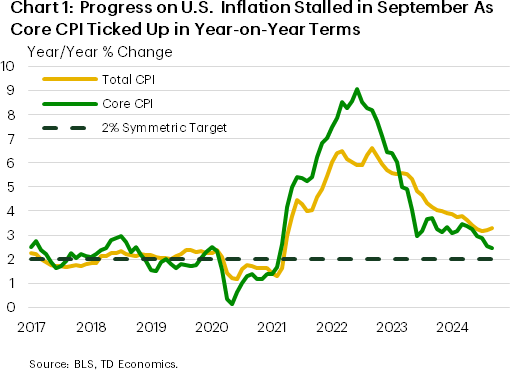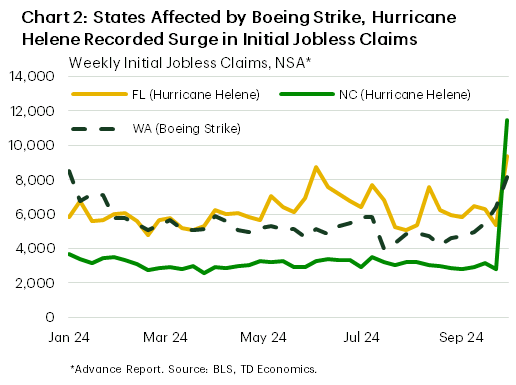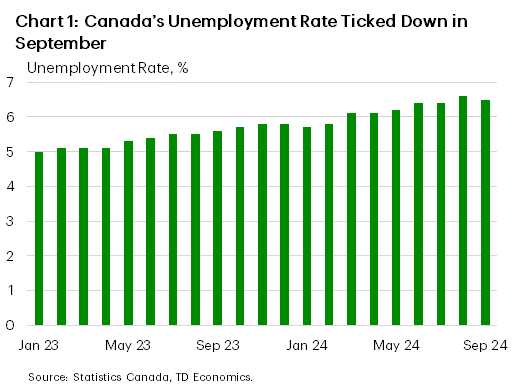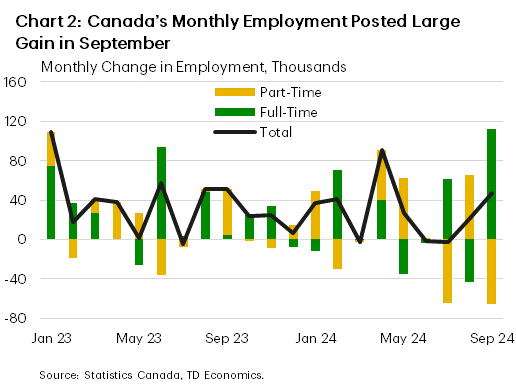U.S. Highlights
- Progress on the inflation front appears to have stalled at the end of the third quarter, as core CPI inflation ticked up, albeit modestly, by 0.1 percentage point to 3.3% year-on-year in September.
- Initial jobless claims surged higher by last week, as states affected by Hurricane Helene (FL, NC) and the ongoing Boeing strike (WA) recorded outsized increases to their unadjusted initial jobless claims.
- Between stronger job growth, and slower progress on inflation, we expect the Fed to cut rates more gradually, with two quarter-point cuts in November and December.
Canadian Highlights
- Canada’s job market defied expectations in September, with the unemployment rate ticking down for the first time since January.
- The better-than-expected jobs data will temper expectations for a 50-basis point cut from the Bank of Canada this month. We expect a 25-basis point reduction in the overnight rate.
- The Bank of Canada’s Business Outlook Survey reaffirms that businesses are feeling the burden of high interest rates, but most are not planning to reduce headcounts and fewer are expecting a recession.
U.S. – Rates to Fall, But Not So Fast
The second week of October continued to reflect the theme that began at last week’s close. A stronger-than-expected payrolls report last Friday drove home the point that the U.S. labor market is holding up better than previously thought, while this week’s CPI report showed progress on the inflation front stalling. All of this suggests that the Fed is likely to slow the pace of rate cuts next month. Bond yields continued the climb higher this week, with the 10-Year yield up another 10 basis points, closing out the week at 4.1%. Equity markets managed to eke out a decent gain, with the S&P 500 up roughly 1% from last week’s close, as of the time of writing.
Total inflation as measured by CPI cooled in September, easing from 2.5% year-on-year (y/y) to 2.4%, largely due to falling energy prices. However, the good news ended there. Core CPI inflation rose a tenth of a percentage point, more than the consensus forecast, which pushed the twelve-month change higher to 3.3% y/y (Chart 1). Price growth in the important ‘shelter’ category eased, though we saw broader price pressures heat up across most other service categories, while core goods prices added to overall inflationary pressure – a first in seven months.
With progress on the inflation front stalling and the labor market holding up well, futures markets are now pricing just an 80% probability that the Fed will cut by 25-basis points next month. Minutes from the last FOMC meeting show that the Fed’s strong start to the easing cycle in September was thought of as a “recalibration” to help bring restrictive monetary policy into “better alignment” with recent indicators of inflation and the labor market, and that this should not be interpreted as the new pace of policy easing over the coming months. We anticipate the Fed will deliver two additional 25 basis point cuts by the end of this year.
However, it’s important to note that the Fed will remain heavily data dependent in setting monetary policy. This will become increasingly difficult over the coming months, with large distortions likely to be seen in October/November data because of Hurricane’s Helene and Milton and the ongoing Boeing strike. Besides the tragic loss of life, the recent hurricanes have left behind a path of destruction in the Southeast, which will exude some near-term weakness.
The impacts of Boeing and Helene appear to already be featuring in employment data, with a sharp jump in initial jobless claims (up 33,000 to a seasonally adjusted 258,000 last week) tied in part to these events. Large increases in initial jobless claims were recorded in affected states such as Florida and North Carolina (Helene) and Washington (Boeing) (see Chart 2). We anticipate the Fed will look past the transient nature of some of these impacts as it continues to ease monetary policy next month, but communication as related to the next cut will require considerable effort given the many factors at play.
Canada – Good news on job market, but businesses remain subdued
Not wanting to be outdone by its southern neighbours, Canada’s jobs data also surprised to the upside this week. Much like last week’s U.S. payroll’s report, September’s Labour Force Survey can only be described as stronger than expected. Employment rose by more than expected in the month and, defying the expectations of most, the unemployment rate fell one tenth to 6.5%. Expectations were for an increase in the unemployment rate to 6.7% (see commentary). While this is positive news on the margin, the overall trend over the last two years is a gradually increasing unemployment rate, with the occasional backtrack in the monthly figures (Chart 1). This development is likely not a game-changer for the outlook. However, it may serve to firm expectations that Canada is closer to a soft landing than recession, and for that reason, it reduces the likelihood that the Bank of Canada will deliver an outsized interest rate reduction in its October decision, like the Federal Reserve did in September.
One reason we don’t see the unexpected positive monthly reading leading to any major dialing back of rate expectations is that the monthly jobs figures have been giving us whiplash for the last several months (Chart 2). The past four months have seen relatively little overall increase in employment, and the changes in part-time and full-time employment in one month have subsequently been undone by the next for four months now. To be sure, September’s jobs gain, which is heavily weighted to full-time employment, will be read as a sign of a labour market that is some distance from faltering. But the past few months of data mean we need to be cautious about reading too much into this.
The Bank of Canada’s Business Outlook Survey for the third quarter was also released on Friday and helps place the September jobs data into context. The overall picture is subdued, but somewhat improved, business conditions compared to last quarter. Firms surveyed by the Bank reported a below-average outlook for sales, but sales expectations have increased since interest rates start declining. Similarly, the share of businesses expecting a recession declined this quarter. Despite these areas of improvement, firms continued to indicate that high interest rates and soft demand were the biggest factors weighing down business conditions. In our view, the Bank of Canada is likely to interpret this survey as supporting the need to continue gradually reducing its policy rate.
This was a light week for Canadian data, today’s two releases being the only major releases all week. Next week, all eyes will be on Tuesday’s inflation data, probably the most important data release before the Bank of Canada’s October decision. Last month, headline inflation came in at 2% on a year-over-year basis, exactly on the Bank of Canada’s target. The jobs report today pushes expectations in the direction of a quarter-point cut in October and we look ahead to the September inflation data for confirmation.


















